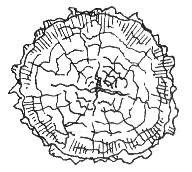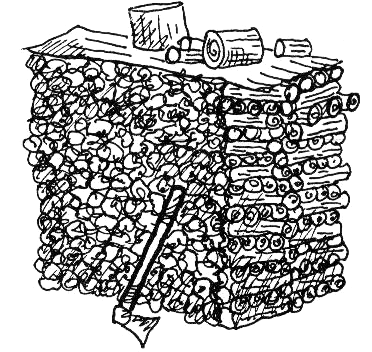Firewood
How to Know you are buying seasoned firewood

The trouble with buying SEASONED firewood is that the firewood supplier is likely to tell you it's well-seasoned when it really isn't. But you're standing there shivering in the snow, eye to eye with that load of wood, and you know better.
"Why that's been standing dead for two years!" he might exclaim. Or, "I felled those trees two years ago, and just cut them up and split them for you this morning. They're plenty seasoned, little lady." The truth of the matter is that standing-dead, storm-downed and felled trees don't season at the same rate as wood that's been split and stacked or piled where the sun and air get to it.
Recognizing seasoned wood
With a bit of practice you can learn to recognize seasoned wood when you see it. One telltale sign is that the bark has loosened its hold, or has already been knocked off with handling. Also, the log ends have darkened, dried out and started to "check" (crack), not to be confused with the deeper split marks from an axe.
A well-seasoned firelog will be lighter in weight than a partially-seasoned or "green" piece of the same size and species. When it really is well seasoned, expect to pay more. Cutting trees down, transporting, handling and working up wood is a risky, labor-intensive pursuit; any do it yourself woodburner will testify to that. The more times a upplier has to handle it and the longer he ties
up space storing it, the more he'll charge. And rightly so.
Last year in the early fall, my son-in-law Tommy pulled in my farm lane with a big pick-up load of firewood from land he'd cleared of hardwood trees a year or more earlier. He dumped it in a pile by the shed, at which point my son Joel took over. He split the larger pieces and stacked it all under one of the open ends of my woodshed. One year later, Tommy's wood was well-seasoned and perfect for burning, ready to produce good, efficient and non-creosote-producing heat if I manage my fires properly. (Even seasoned wood generates some creosote in a fire starved for air.)
This fall my son Tim and his wife Jane, as one of their chores for the family's annual "work day at Mom's," gathered a pick-up load of storm-downed limbs from the side of my lane. They cut it up with chainsaw and then after using the splitting maul it was ready to be stacked it in the woodshed to start the seasoning process.
Seasoned wood is easy to recognize:
- The ends have darkened and started to crack, the bark has loosened or fallen away. It's lighter in weight than an unseasoned piece of the same species. You can still make out the raised mark of the chainsaw on the cut ends of "green" firewood.
- Tim promised to bring me another truckful soon. The seasoned load he delivered a month or so later was from his own holz hausen, a traditional German firewood-curing stack he and Jane had built only six months earlier. These well engineered round woodpiles, which speed the seasoning process, are not all that hard to construct and can hold several cords of wood.

Split and Stacked Cord Wood
Firewood can be stacked in the open to season. It will take at least six months. A year is better, although some species require far less time than others. Criss-cross the ends of the stack to help the air get to it. Splitting the logs will hasten seasoning. Rain won't hurt green wood; in fact, getting wet, and the continual dry, wet, dry speeds the curing process. And rained-on seasoned wood will dry out again fit for burning within a few days.
Last winter I was close to running out of seasoned wood and ordered some through a local classified ad. After quizzing him as to what his firewood "looked like," I told him to go ahead and deliever a load. He brought a good mix of well-seasoned hardwoods and softwoods.
But you can't count on that! So get to know some of your local sellers. See what type of operation they run, then order your firewood in the spring or summer, at least a year ahead of when you intend to burn it.
Around here it's more often sold by the truckload than by the cord. If the seller describes it as "a face cord" as much as a well-loaded 3/4 ton pick-up truck can carry, it should measure 4 feet high, 18 inches (or firewood length) deep and 8 feet long, tightly stacked. A full cord measures 4x4x8 feet, or 128 cubic feet.
You'll find a variety of prices with any serious professional cordwood supplier, depending on type softwoods, hard-woods, in-betweens, quantity ordered, time of year, split or unsplit, dumped or stacked... and combinations thereof. Prices will vary tremendously from area to area.
You say you're in a bind now, and it 's winter? Seek out the species that require less seasoning, such as Hickory, Osage Orange, Douglas Fir, and most Ash. And better planning next time!

In keeping with tradition here we are three generations of Chimney Sweeps serving Dufferin County, Caledon, Erin and Palgrave areas.
For decades people have had a love affair with wood fires, a cosy fire on a cold blustery night curled up with a good book and a warm drink is the ultimate in comfort on a winter evening. "The perfect fire" is "all woodheat can be.

Give Us a Call
Phone: 519-941-5213

Send Us an Email
thechimneysweep@sympatico.ca
Home | About Us | Services | FAQ’s | Knowledge Base | Resources | Contact Us
Website Design by Rood's Media




